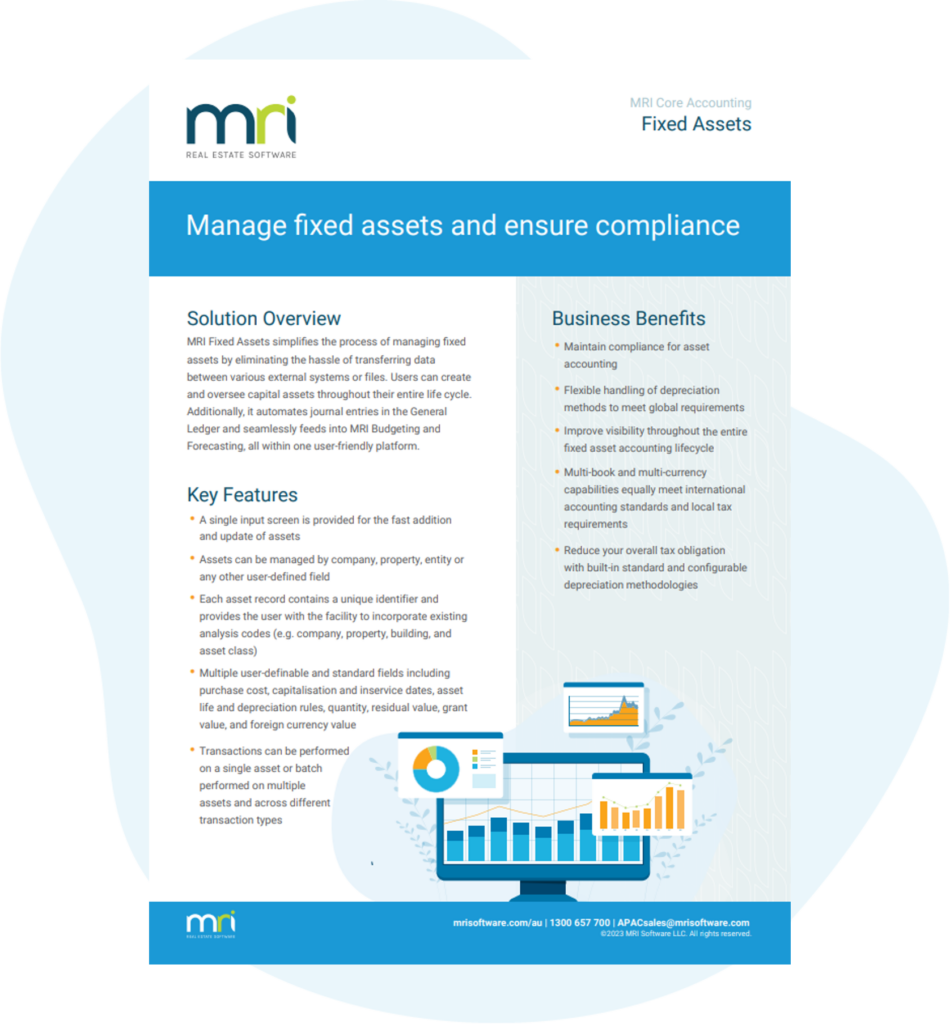What is a capital improvement plan?
A capital improvement plan is an essential tool for property owners and managers who want to maintain and grow the value of their assets. For commercial landlords, the plan serves as a roadmap for significant property investments that extend the useful life of buildings, improve tenant satisfaction, and ensure compliance with regulations. These plans outline where money should be allocated, how projects should be prioritised, and what outcomes should be achieved over time.
Fixed Asset Management software
Have confidence in the accuracy of your asset register and get the data you need at the touch of a button.

Contents:
- Why capital improvement planning matters
- Key components of a capital improvement plan
- Capital improvements vs. Maintenance: what’s the difference?
- How real estate software supports capital planning
- Best practices for implementing a capital improvement plan
- Capital planning in action: example scenarios
- FAQs
Effective planning requires careful consideration of asset management principles. When you manage a large portfolio, knowing the current state of each property and forecasting future requirements ensures that funds are directed where they will have the greatest impact. Defining your levels of service also helps establish clear expectations for tenants, investors, and stakeholders. By understanding how different standards affect long-term operations, you can make better decisions about upgrades and improvements.
At MRI Software, we understand that the process of assets management involves balancing short-term repairs with long-term capital improvements. Without this balance, properties can fall behind in market appeal and compliance. Planning also helps you anticipate future challenges before they become costly emergencies. When carried out effectively, a capital improvement plan becomes an essential management tool for sustaining property performance.
Why capital improvement planning matters
Capital planning is more than just allocating money to projects. It provides direction for managing property over several years. For landlords, this means anticipating future needs, controlling costs, and ensuring that your assets remain competitive in the market. Without a plan, spending often becomes reactive and scattered, leading to higher long-term costs.
Long-term value creation through strategic upgrades
One of the most important benefits of a capital improvement plan is its role in creating long-term value. Upgrades such as modern HVAC systems, updated lobbies, or improved energy efficiency not only extend the useful life of buildings but also enhance tenant satisfaction. Tenants are more likely to remain in properties that are well maintained and modernised. A structured plan ensures that improvements align with long-term goals rather than short-term fixes.
Risk mitigation and budget control
Unexpected failures in property systems can be extremely costly. A failing roof or outdated fire safety system can lead to significant financial exposure. Capital improvement planning identifies these risks early, giving you the ability to schedule replacements before emergencies occur. By spreading costs across a multi-year plan, you avoid sudden budget shocks. This approach creates stability and allows you to control cash flow while protecting the value of your investments.
How it supports asset lifecycle management
Every asset has a lifecycle, from installation through use to eventual replacement. Capital improvement plans help you track these lifecycles and prepare for key milestones. When you integrate capital planning into broader asset lifecycle management, you gain a clear picture of when assets need replacement and how much that replacement will cost. This alignment ensures that upgrades are not left until the last minute, reducing downtime and disruption for tenants.
Key components of a capital improvement plan
A strong capital improvement plan is built from several key components. Each of these elements plays an important role in ensuring that projects are identified, prioritised, funded, and delivered in a way that supports long-term property performance. When these components are combined, they create a framework that provides both structure and flexibility for managing complex portfolios.
Asset inventory and condition assessment
The starting point for any plan is a detailed record of the assets within your portfolio. This includes major building systems such as roofing, plumbing, HVAC, elevators, and electrical networks, along with structural components and shared facilities. Having a clear inventory prevents blind spots and ensures that every part of the property is accounted for.
Once the inventory is complete, each asset should be evaluated to determine its current condition. Inspections provide essential data about useful life, performance, and potential risks. For example, a roof nearing the end of its lifespan will be marked as a high priority, while a recently upgraded elevator may only require standard monitoring. These assessments create a baseline for decision-making.
Prioritisation framework
Not all projects can be completed at once, which means establishing a transparent prioritisation framework is critical. Some projects may demand immediate attention because of safety risks or regulatory requirements. Others may be valuable because they deliver measurable financial returns, such as energy efficiency upgrades that reduce utility costs. A framework that ranks projects by urgency, return on investment, and compliance needs ensures that limited resources are directed to the most important improvements. This method also provides clarity when communicating with tenants or investors about why certain projects are being addressed first.
Budgeting and multi-year forecasting
Capital improvement plans extend beyond a single budget cycle. They typically look three to ten years into the future, mapping out when projects should occur and how they will be funded. Forecasting allows costs to be spread across several years, which reduces the burden on any one budget and ensures that large expenses do not arrive as sudden surprises. For example, a roof replacement may be scheduled for year one due to leaks, while an HVAC upgrade could be planned for year two to improve efficiency. By forecasting in this way, you can align spending with expected revenue and maintain financial stability.
Stakeholder input and approval cycles
A plan is most effective when it reflects the perspectives of everyone involved in property management. Tenants may raise concerns about comfort or functionality, while investors focus on financial returns. Facilities teams often highlight practical maintenance needs, and finance departments concentrate on cost allocation. Involving these groups through structured approval cycles ensures that the plan is balanced and accountable. Once input is gathered, the approval process formalises decisions, creates transparency, and helps secure long-term support. When stakeholders understand the reasoning behind the plan, they are more likely to commit to the necessary investments and timeframes.
When you bring these components together, the plan becomes more than a list of projects. It develops into a strategic tool that guides decisions, supports financial stability, and ensures that every asset is maintained and upgraded in a way that aligns with long-term goals.
Capital improvements vs. Maintenance: what’s the difference?
Understanding the difference between capital improvements and maintenance is essential for accurate planning. Both are necessary, but they serve different purposes and are accounted for differently.
Defining capital vs. Operational expenses
Capital improvements are significant projects that extend the life of an asset or add new value. Examples include replacing a roof, upgrading an HVAC system, or renovating a lobby. Maintenance refers to routine tasks that keep existing systems running, such as servicing air conditioning units or patching small roof leaks. Capital expenses are usually larger, less frequent, and require formal planning.
Tax and accounting implications
From an accounting perspective, capital improvements are often depreciated over time, while maintenance expenses are deducted in the year they occur. Understanding this difference is crucial for accurate financial reporting. Misclassifying expenses can lead to compliance issues or missed tax benefits. Capital improvement planning ensures that spending is categorised correctly, providing clarity for accountants and auditors.
How software helps classify and track spending
Managing the distinction between capital improvements and maintenance can be complex, especially across large portfolios. Real estate software helps by centralising data, tracking spending, and ensuring proper categorisation. With clear records, you can demonstrate compliance, plan for tax implications, and analyse where resources are being used.
How real estate software supports capital planning
Modern software plays a vital role in capital improvement planning. It provides visibility, accuracy, and efficiency for managing complex portfolios.
Centralising asset data for smarter decisions
When all asset data is stored in one system, decision-making becomes more accurate. Centralisation reduces the risk of missing information and allows you to analyse the entire portfolio at once. This holistic view highlights where resources should be focused and identifies trends across properties.
Forecasting costs and scheduling projects
Software tools provide forecasting capabilities that help you plan budgets years in advance. By analysing historical data and condition assessments, you can predict when assets will need replacement. Scheduling projects becomes easier when supported by accurate forecasts, ensuring that work is carried out at the right time without disrupting operations.
Integrating with lease, budget, and maintenance modules
Capital planning does not happen in isolation. Integration with lease management ensures that improvement projects align with tenant agreements. Budget modules allow for real-time financial tracking, while maintenance modules connect daily work orders with long-term capital strategies. This integration ensures that every part of the business is aligned, reducing duplication and improving efficiency.
Best practices for implementing a capital improvement plan
A capital improvement plan is most effective when it is implemented with care and attention to detail. Certain practices can help you get the best outcomes.
Data accuracy and real-time updates
Accurate data is the foundation of reliable planning. Regular inspections and real-time updates ensure that condition assessments remain current. Outdated data can lead to poor decisions, so consistent monitoring is essential. Digital tools make it easier to maintain accuracy by capturing updates as they occur.
Cross-department collaboration
Capital planning involves input from finance, facilities, and operations teams. Collaboration ensures that all perspectives are considered. For example, facilities teams may identify urgent building needs, while finance teams provide guidance on funding availability. A collaborative approach creates balanced plans that address both operational and financial requirements.
Reviewing and revising the plan annually
Properties and markets change over time. Reviewing the plan annually allows you to adjust for new priorities, unexpected issues, or shifts in tenant demand. Regular reviews keep the plan relevant and ensure that long-term goals are being met.
Capital planning in action: example scenarios
Examples help demonstrate how capital improvement planning works in real situations.
Multi-property portfolio upgrade
A landlord managing several apartment complexes may identify outdated plumbing systems across multiple buildings. By creating a capital improvement plan, the landlord can schedule replacements over several years, reducing disruption for tenants while spreading costs evenly.
Commercial HVAC replacement planning
A commercial landlord with several office towers may face the challenge of ageing HVAC systems. Rather than replacing systems reactively, a plan allows the landlord to stagger replacements, align upgrades with energy efficiency goals, and budget more effectively.
Government or campus infrastructure overhaul
Public sector organisations often manage extensive infrastructure, such as schools or government buildings. Capital improvement planning enables them to schedule upgrades systematically, ensuring compliance with safety standards while maintaining service levels for the community.
FAQs
Contact MRI Software
Capital improvement planning is a powerful tool for protecting and growing the value of your properties. To learn more about how technology can support your strategy, contact MRI Software on 1300 657 700.
Streamline Fixed Asset Management and Maintain Compliance
Experience the simplicity of overseeing your fixed assets with MRI Fixed Asset Accounting. Our intuitive platform reduces data transfer complexities across systems, ensuring smooth asset management for their entire lifecycle. Enhance your MRI platfor…
